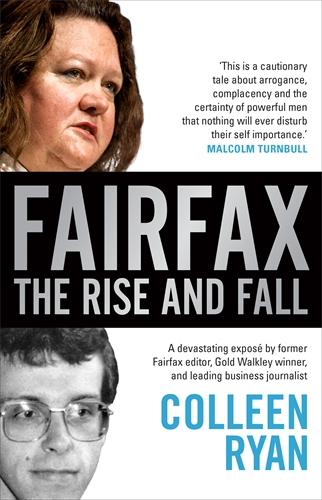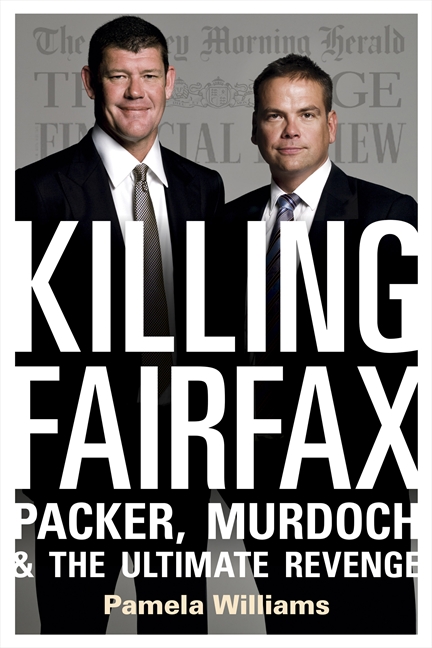Inexorably winnowed: Fairfax: The Rise and Fall & Killing Fairfax
There is a pungent irony in the publication of these two books about the declining fortunes of the Fairfax Media company written by two of its most experienced and respected journalists. Media companies matter and journalism matters, but it is entirely possible that Fairfax, which was founded in Sydney in 1841, will in the next year or two be dissolved or broken up or taken over by Australia’s richest person, Gina Rinehart. And it is certainly true that the tradition of big city newsroom journalism that bred the authors of these books is being inexorably winnowed.
Good riddance, some would no doubt say. Media moguls both here and overseas have not exactly covered themselves in glory of late, and journalists, historically an unloved tribe, have had the rushed and superficial nature of much of their work exposed by the instant and ubiquitous transparency of the internet.
The demise or even continued bleeding of the Fairfax Media company, though, would worsen an already heavily concentrated news media landscape. An international study being coordinated by Columbia University in the United States has found that Australia has the most highly concentrated print media ownership among the 26 countries surveyed. Rupert Murdoch’s News Corporation owns fourteen of the 22 national, metropolitan daily and Sunday newspapers published in Australia; Fairfax Media owns seven; West Australian Newspapers owns one.
It is commonplace to deride newspapers as a dinosaur medium, but their online arms still routinely head the lists of the most popular news websites in Australia, with Fairfax Media’s www.smh.com.au usually in top spot. Newspapers have long been the engine room of what Eric Beecher, proprietor of Private Media Partners, calls ‘public interest’ journalism – that is, journalism that keeps a watching brief on society’s main institutions. This role may be diminishing as the big city newsrooms are hollowed out, but it remains important for journalism and by extension for democratic societies.
It is a role that has been in some ways supplanted or even augmented by the new forms of journalism that have flourished in the internet age: blogs, small independent start-ups, special interest websites. This certainly has been a welcome development, but it is highly unlikely that any of the numerous outlets scattered through cyberspace can command the attention of governments in the way that the Murdoch name does. It is true that the ability in recent years of WikiLeaks to publish instantly and globally vast tranches of documents that governments and military leaders would like to keep hidden has exponentially expanded the scale and impact of the traditional ‘leak’ or ‘scoop’. But the threat posed to governments by the WikiLeaks model has provoked a ferocious campaign to stifle it, which is one of the reasons the organisation’s founding editor, Julian Assange, remains holed up in the Ecuadorean embassy in London. A similar challenge to governments, and a similarly fierce response, has played out this year since the Guardian reported the revelations by Edward Snowden about government overreach of eavesdropping powers.
What all this suggests is, first, that whatever changes the new communication technologies have wrought, there remains a need for independent scrutiny of those in positions of power and authority and, second, that whatever advances these new technologies have made in bringing about greater transparency need to be balanced against what is being lost through the winnowing of what is termed the legacy media.
The two books under review, then, are important for their subject matter and for what they have to tell us about the fate of Fairfax Media and those who sail within it. The fortunes of other media companies, such as Seven West Media and Foxtel, and of other media proprietors, such as James Packer, Lachlan Murdoch and Kerry Stokes, are brought in at the points they intersect with Fairfax. The way the authors tell their stories exemplifies much that is good about twentieth century journalism; the parts of the story they don’t tell illustrates its blind spots. But I am getting ahead of myself. First, you need a sense of the story that Ryan and Williams do tell.
The print media has always been a hybrid business. It is about selling space to advertisers to reach prospective customers. But early on newspaper proprietors realised that those prospective customers were more likely to read the ads if they were surrounded by interesting and entertaining information. News is perennially interesting. Media historian Mitchell Stephens has written that he has not been able to find a society, past or present, that lacked a hunger for news.
To find the news, to verify it, to print and distribute it costs money in wages for journalists, in paper, and in the trucks to deliver what was called ‘the daily miracle’. Media companies like Fairfax earned a portion of their revenue from the price of the newspaper, but the bulk of it they earned from advertising. The public, beginning as long ago as the mid-nineteenth century, became accustomed to receiving their daily paper for next to nothing, which worked for them. It worked for the newspaper companies, too, who earned plump profits. Handsome rates for advertisements could be charged because the hefty costs of production and distribution ensured there were few, if any, competitors to the main newspaper companies.
Successive generations of the Fairfax family combined a deep and abiding interest in the affairs of the day with commercial acumen, or at least the sense to hire people with commercial acumen. This has been well documented in Gavin Souter’s two histories of the Fairfax company, Company of Heralds (1981) and Heralds and Angels (1991), and is reprised in Ryan’s book. The family was conservative, patrician and not above meddling in the coverage of a federal election, as they did in 1961 when, angered by the Menzies government’s economic policies, Warwick Fairfax took the rare step of siding with the ALP. His managing director, Rupert Henderson, virtually became Labor leader Arthur Calwell’s campaign manager.
When James Fairfax became chairman in 1976, he encouraged greater autonomy among editors and so developed the robust journalistic culture that reached its zenith and then overreached itself in the 1980s. In 1987, Warwick Fairfax Jr. launched his disastrous bid to take over the company, which blew apart the family and then imploded when the share market crashed later that year. In 1991, just two months short of a sesquicentenary, the oldest media dynasty in the world was put into receivership. Several books were written chronicling Young Warwick’s folly; what could not be seen then was how vulnerable the company would be when it was re-formed without a dominant proprietor but as a publicly listed company with an open and volatile share register. The collapse in recent years of the company’s share price and the laying off of 1900 staff in 2012 has prompted another rash of books. In addition to Ryan’s Fairfax: The Rise and Fall and Williams’ Killing Fairfax, another book by another veteran Fairfax journalist, Ben Hills, is still in the offing.
For much of its long history, classified advertisments afforded Fairfax a level of profitability that was envied by other media proprietors, such as the Packer family and Rupert Murdoch, who famously dubbed them the ‘rivers of gold’. Under the stern stewardship of Rupert ‘Rags’ Henderson, Fairfax protected this territory against all comers so successfully that competitors had all but given up on wresting it from the company.
Illustrating the maxim that sometimes your greatest strength can be your greatest weakness, Fairfax failed to protect its classified advertising revenue when the internet arrived and tore apart the print media’s longstanding business model. The elegantly compiled bundle of news, entertainment, service information and advertisements that was the twentieth century newspaper, was unstitched by the internet, which enabled the creation of stand alone websites meeting customers’ individual needs. By the mid-2000s, if you wanted to hunt for a house or a car or a job you could do that for free. Instead of wading through pages of newsprint, you could narrow your search and quickly turn up precise information. The new online classified advertising sites could undercut Fairfax’s rates because they were in that business only and so had none of the other costs associated with gathering and distributing news.
Hindsight is of course a handy tool, but the executive leadership, including the managing director between 1998 and 2005 Fred Hilmer (but not only him), comes across in these two books as an unhappy combination of arrogant, complacent and slow-footed. Their moves into the internet, such as the search directory Citysearch, were overtaken by all-encompassing search engines like Google, and they were stymied at various critical points by the continual factionalised in-fighting on the Fairfax board and what Williams describes as the Machiavellian culture in the company’s Sydney headquarters.
It is easy to heap scorn, especially on Hilmer, but no mainstream print media company in the English-speaking world has yet found a successful replacement for the previous business model. Even acknowledged media business giants, like Murdoch, for many years misread the potential importance of the internet. Even so, it is a sobering fact laid before readers by both Williams and Ryan that John B. Fairfax, who left the company in disgust after Warwick Fairfax Jr.’s takeover bid, and who rode back into it in late-2006 when Rural Press merged with Fairfax to become Fairfax Media, eventually lost more money than young Warwick. Some $900 million was wiped from the value of his investment between 2006 and when he sold out of the company five years later.
It took about a decade for the changes made possible by the internet to unfold, but they are now irreversible. As Daniel Petre, a new media pioneer who was managing director of Kerry Packer’s internet offshoot company, Ecorp, told Ryan: ‘Eight billion dollars of market cap [stock market valuation] is now tied up in REA [realestate.com.au], Carsales and Seek. That has basically come out of Fairfax. And Fairfax is worth $1.3 billion. That is the scale of the tragedy’. At its peak, in March 2000, the Fairfax share price was $6.24; its lowest ebb so far has been 38 cents, in November 2012. For much of 2013, it has hovered around 60 cents.
In the end, it is hard to disagree with Ryan’s blunt assessment that ‘incompetent management and lacklustre boards’ saw the revenue streams from classified advertisements flow to online start-ups. She is particularly scathing about the back-biting at the company’s most senior levels, which she likens to the nastiness of ten-year-old schoolboys.
These two books are the work of accomplished journalists. They know their topic, they have a strong sense of the stakes involved in Fairfax Media’s troubles, and they have made good use of the time and space afforded by a book, as distinct from a newspaper feature, to go back to the key board members and senior executives to extract their accounts of events and their reflections on them. Accordingly, readers are offered a good deal more than was revealed at the time about what was happening in the Fairfax boardroom and greater insight into how the fledgling internet companies developed. Newspaper accounts of events as they are unfolding are necessarily incremental and, to a greater or lesser degree, cryptic, as daily journalists are rarely afforded the time to make sense of contested and clouded developments. I know because I reported on many of the events Ryan and Williams cover when I was working as Media and Communications editor for the Age. What was hinted at, or what I intuited at the time, has here been put on the record and fleshed out.
Williams and Ryan make important contributions to our understanding of Fairfax’s current state, though in my view both books have shortcomings. Ryan is virtually absent as a narrator in Fairfax: The Rise and Fall, even though she has been a senior editorial executive at Fairfax for many years. It is not clear how much she knows first-hand and how much she has gathered subsequently. She has followed the newsroom lore of not making herself the story, and it may well be that the reader does not need to know any more about her role in Fairfax’s recent history. But the veil she draws across what she thinks and feels about her time at Fairfax seems to me ill-suited to a book about a media company in which she worked for 35 years.
Williams is a star reporter for the Financial Review but has not been an editorial executive. She practices a form of what is known as source journalism: she has assiduously courted an extraordinary array of highly placed media and business executives, who talked to her both on the record and, it would appear, even more on background. The endnotes are sprinkled with their names. Williams even obtained an interview with Rupert Murdoch – rare for a journalist employed by Fairfax. What this means is that she can give readers enticing accounts of what the rich and powerful said to one another as they contemplated their next move. This is territory that in the United States Bob Woodward has made his own. Source journalism offers the reader material they almost never get in the daily media, but the trade-off for the exclusive access is that you need to keep your powerful sources happy, and that means you risk becoming their mouthpiece.
Readers do not know what has been left out, but they can perhaps glean it by seeing who is treated well in Williams’ account (James Packer and Lachlan Murdoch especially so). The seams also show in the two-dimensional characterisations of the main people who figure in Killing Fairfax. The text is garlanded with descriptions of the colour of men’s ties and of meetings between key players in exclusive eateries like Rockpool, or on yachts and private planes.
Both books are Sydney-centric and treat the Sydney Morning Herald as the centre of the journalistic universe. As a former journalist with the Age (for two stints), I am happy to declare a bias, but I have read enough media history to know this approach undervalues the contribution of a broad range of Fairfax outlets other than the Sydney Morning Herald. Similarly, both books emphasise the activities of the Fairfax board at the expense of other parts of the company’s activities.
In this, Fairfax: The Rise and Fall and especially Killing Fairfax are, as Sybil Nolan has put it, ‘business procedurals’. It is worrying that two senior journalists underplay the role of journalism and the news media in a democratic society. As the title of Julieanne Schultz’s 1994 book pointed out, the media is ‘not just another business’.
Of course, journalism is a business and one of the key lessons of the events chronicled in these two books is that without a sound business model it is impossible to properly resource newsrooms. There is no doubt that much of the journalism produced every day is ephemeral or about diverting the reader, but the free flow of information and ideas in society is vital and a robust news media is integral to that process. The quickest way to see this is to look at what happens in countries where information does not flow, like North Korea, or is tightly controlled, like China, or where vigorous scrutiny of those in power is punished, like Russia, where investigative journalist Anna Politkovskaya was murdered some years ago.
Such appalling events have not happened in Australia, but these issues exist along a continuum. The struggle between government and media over information is still an important issue in Australia, as is illustrated in the weekly ‘briefings’ by the newly appointed Immigration Minister Scott Morrison about unauthorised boat arrivals.
Fairfax Media may be in its death throes, or it may be slowly making the transition to a digital media company. I certainly do not want to see the end of a company that has made such an important contribution to Australian life, but if in making that transition Fairfax has to reduce its journalistic workforce to skeletal levels, which is what has been happening for the past few years, what is the point? You are not able to impose much journalistic muscle or editorial heft on an issue like government treatment of asylum seekers, and you are no longer making much money because Seek and Carsales and REA have gobbled up that market. And you are probably not having much fun either.







